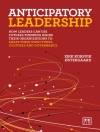Designing and Managing a Research Project: A Business Student’s Guide is a practical, step-by-step guide that shows business students how to successfully conduct a research project, from choosing the topic to presenting the results. The authors have applied their many years of experience in supervising student projects to provide examples of actual research problems and to offer practical solutions. The inclusion of topics such as supervision, group work and ethics, and both qualitative and quantitative data analysis, along with examples from real student research provide a unique perspective.
The new
Fourth Edition includes broader types of student project examples, such as an Economics thesis, additional international business cases, increased coverage of Questionnaire Design and Institutional Review Boards, and an integrated case throughout the book on ‘High Performance Shoes’ with supporting materials and data.
Additional resources including case studies, Power Point slides, and test bank are available on the authors’ website.
Cuprins
Preface
Acknowledgments
PART I. THE FOUNDATIONS
CHAPTER 1. Introduction
What Is Research?
How a Research Project Fits Within Your Business Education
Overview of the Book
Online Support Materials
Case Study
Chapter Questions
References
CHAPTER 2. Choosing a Topic
Has the Topic Been Assigned?
Steps in Choosing a Topic
Project Checklist
Case Study
Chapter Questions
References
CHAPTER 3. The Role of the Supervisor
Understanding Your Supervisor
What Is the Role of a Supervisor?
Selecting a Supervisor
Other Supervisor Arrangements
Ground Rules and Expectations
Conclusion
Project Checklist
Case Study
Chapter Questions
References
CHAPTER 4. Group Work, Group Dynamics, and the Role of Conflict
The Group Work Process
Why Assignments Use Groups
The Complexity of Group Work
Group Work and Conflict
Positive and Negative Conflict
General Causes of Conflict
Conflict Stimulation
Managing Conflict
Conclusion
Project Checklist
Case Study
Chapter Questions
References
CHAPTER 5. Ethical Considerations
What Is Human Intervention?
Codes of Ethical Conduct/Practice
Ethical Philosophies
Ethical Issues to Consider
Technology Issues
Conclusion
Project Checklist
Case Study
Chapter Questions
References
PART II. UNDERTAKING THE RESEARCH
CHAPTER 6. Planning the Research Project
Importance of Planning
The Research Process
The Research Proposal
Managing the Research Process
Budgeting
Conclusion
Project Checklist
Case Study
Chapter Questions
References
CHAPTER 7. Literature Review
What Is a Literature Review?
How Can Literature Be Used?
Where to Obtain Literature
How to Write a Literature Review
Referencing
Managing Your References
Project Checklist
Case Study
Chapter Questions
References
CHAPTER 8. Data Gathering
Factors to Evaluate Data-Gathering Methods
Types of Research Data
Secondary Data
Primary Data
Sampling Methods
Research Errors
Conclusion
Project Checklist
Case Study
Chapter Questions
Appendix 8.1: Statistical Agencies that Provide for Up-to-date Demographics and Country Data
References
CHAPTER 9. Qualitative Data Collection and Issues in Analysis
Qualitative Data Collection Methods
Implementation
Analysis and Interpretation
Conclusion
Project Checklist
Case Study
Chapter Questions
References
Further Reading
CHAPTER 10. Quantitative Data Analysis
Hypotheses, Errors, and Significance
Basic Analysis
Basic Associations
Basic Causal Relationship
Introducing Advanced Techniques
Conclusion
Project Checklist
Glossary
Case Study
Chapter Questions
References
Further Reading
PART III. COMMUNICATING THE RESULTS
CHAPTER 11. Presenting the Results
Ways to Present Research Findings
Numerical Tables
APA Style
Charts and Graphs
Pictures
Maps
Quotations
Reporting Statistical Results
Conclusion
Project Checklist
Case Study
Chapter Questions
References
CHAPTER 12. Identifying the Implications and Establishing Recommendations
Describing the Results
Discussion and Interpretation
Research Implications
Recommendation Guidelines
Limitations
Future Research
Project Checklist
Case Study
Chapter Questions
References
CHAPTER 13. Writing the Report
Written Communication
When to Write?
Types of Reports
Structure of a Project Report
Conclusion
Project Checklist
Case Study
Chapter Questions
References
CHAPTER 14. Oral Presentations
Before the Presentation
The Presentation
Wrapping Up
Groups and Group Members in Presentations
Conclusion
Project Checklist
Case Study
Chapter Questions
References
CHAPTER 15. Concluding Remarks
Some Final Hints for Those Undertaking a Project
Case Study (Epilogue)
About the Authors
Index
Despre autor
David S. Waller (Ph.D) is a Senior Lecturer in Marketing at the University of Technology Sydney, Australia. David was born and raised in Sydney and, after working in the banking and film industries, taught at a number of universities in Australia, including the University of Newcastle, the University of New South Wales, and Charles Sturt University. David has a Bachelor of Arts from the University of Sydney, a Master of Commerce from the University of New South Wales, and a Ph.D from the University of Newcastle. His research interests include advertising agencies, agency– client relationships, controversial advertising, international advertising, and marketing education. David has published a wide range of journal articles, including the Journal of Advertising, Journal of Advertising Research, European Journal of Marketing, and Journal of Business Ethics, primarily relating to advertising and marketing communication, and is a regular presenter at academic conferences. He has also authored/co-authored a number of university-level textbooks and workbooks which are used in several countries.












